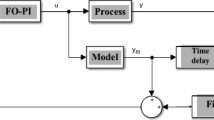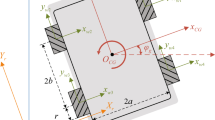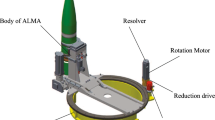Abstract
This paper presents the design of fast terminal sliding mode control based on feed forward neural network (FTSMC\(+\)NN) for a polymerization reactor in the presence of unknown disturbances. The FTSMC+NN offers robust trajectory tracking of the monomer concentration and the reactor temperature. The NN is employed to approximate the unknown complex dynamics and the external disturbances. Additionally, in order to avoid the chattering phenomenon, a continuous reaching law together with an adaptive gain estimator is adopted. The proposed controller showcases superior performances compared to the SMC and proportional-integral-derivative (PID) controller.








Similar content being viewed by others
References
Jonathan C, Greeves N, Warren SG (2012) Organic chemistry. Oxford University Press, Oxford
Allcock HR, Lampe FW, Mark JE (2003) Contemporary polymer chemistry, 3rd edn. Pearson Education, Inc (Pearson/Prentice Hall), Upper Saddle River
Levenspiel O (2002) The chemical reactor omnibook. Oregon State University Bookstores, Upper Saddle River
Kong J, Chen X (2019) Dynamic optimization of batch free radical polymerization with conditional modeling formulation through the adaptive smoothing strategy. Comput Chem Eng 120:15–29
Richards JR, Congalidis JP (2006) Measurement and control of polymerization reactors. Comput Chem Eng 30:1447–1463
McKeen LW (2008) 10-high temperature polymers. In: McKeen LW (ed) Effect of temperature and other factors on plastics and elastomers, 2nd edn. William Andrew Publishing, Norwich, Plastics Design Library, pp 503–550
Florenzano FH, Strelitzki R, Reed WF (1998) Absolute, on-line monitoring of molar mass during polymerization reactions. Macromolecules 31(21):7226–7238
McAfee T, Leonardi N, Montgomery R, Siqueira J, Zekoski T, Drenski MF, Reed WF (2016) Automatic control of polymer molecular weight during synthesis. Macromolecules 49(19):7170–7183
Kreft Tomasz, Reed Wayne F (2009) Predictive control and verification of conversion kinetics and polymer molecular weight in semi-batch free radical homopolymer reactions. Eur Polym Journal 45(8):2288–2303
Kreft T, Reed WF (2009) Predictive control of average composition and molecular weight distributions in semi-batch free radical copolymerization reactions. Macromolecules 42(15):5558–5565
Leu Giuseppe, Baratti Roberto (2000) An extended Kalman filtering approach with a criterion to set its tuning parameters; application to a catalytic reactor. Comput Chem Eng 23(11–12):1839–1849
Dochain D, Pauss A (1998) On-line estimation of microbial specific growth-rates: an illustrative case study. Can J Chem Eng 66(4):626–631
Salas S, Ghadipasha N, Zhu W, Mcafee T, Zekoski T, Reed W, Romagnoli J (2018) Framework design for weight-average molecular weight control in semi-batch polymerization. Control Eng Pract 78:12–23
Kupilik MJ, Vincent TL (2011) Estimation of biogas composition in a catalytic reactor via an extended kalman filter. In: 2011 IEEE international conference on control applications (CCA), pp 768–773
Li R, Corripio AB, Henson MA, Kurtz MJ (2004) On-line state and parameter estimation of EPDM polymerization reactors using a hierarchical extended Kalman filter. J Process Control 14(8):837–852
Park M-J, Hur S-M, Rhee H-K (2002) Online estimation and control of polymer quality in a copolymerizationreactor. AIChE J 48(5):1013–1021
Cheng Z, Liu X (2015) Optimal online soft sensor for product quality monitoring in propylene polymerization process. Neurocomputing 149:1216–1224
Bustos G, Ferramosca A, Godoy J, Gonzalez A (2016) Application of model predictive control suitable for closed-loop re-identification to a polymerization reactor. J Process Control 44:1–13
Wu S, Jin Q, Zhang R, Zhang J, Gao F (2017) Improved design of constrained model predictive tracking control for batch processes against unknown uncertainties. ISA Trans 69:273–280
BenAmor S, Doyle FJ, McFarlane R (2004) Polymer grade transition control using advanced real-time optimization software. J Process Control 14(4):349–364
Nagy ZK, Braatz RD (2003) Robust nonlinear model predictive control of batch processes. AIChE J 49(7):1776–1786
Lucia S, Finkler T, Engell S (2013) Multi-stage nonlinear model predictive control applied to a semi-batch polymerization reactor under uncertainty. J Process Control 23(9):1306–1319
Chen C-T (2012) A sliding mode control strategy for temperature trajectory tracking in batch processes. IFAC Proc Vol 45(15):644–649 8th IFAC Symposium on Advanced Control of Chemical Processes
Narwekar K, Shah VA (2020) Temperature control using sliding mode control: An experimental approach. In: Tuba M, Akashe S, Joshi A (eds) Information and communication technology for sustainable development. Springer, Singapore, pp 531–538
Kadu CB, Khandekar AA, Patil CY (2018) Sliding mode controller with state observer for tito systems with time delay. Int J Dyn Control 6(2):99–808
Aguilar-López R, Maya-Yescas R (2005) State estimation for nonlinear systems under model uncertainties: a classof sliding-mode observers. J Process Control 15(3):363–370
Rahman AF, Spurgeon SK, Yan XG (2011) Sliding mode observer based control for a continuous fermentation process. Trans Inst Meas Control 34(7):769–779
Uçak K, Öke Günel G (2020) An adaptive sliding mode controller based on online support vector regression for nonlinear systems. Soft Comput 24(8):4623–4643
Sinha A, Mishra RK (2018) Control of a nonlinear continuous stirred tank reactor via event triggered sliding modes. Chem Eng Sci 187:52–59
Aumi S, Mhaskar P (2013) An adaptive data-based modeling approach for predictive control of batch systems. Chem Eng Sci 91:11–21
Wu H, Chen Y Wang J (2017) Model-free output feedback control of molecular weight distribution. In: 2017 6th data driven control and learning systems (DDCLS), Chongqing, pp 473-478
Yuan Ping, Zhang Bi, Mao Zhizhong (2017) A self-tuning control method for Wiener nonlinear systems and its application to process control problems. Chin J Chem Eng 25(2):193–201
Kamesh R, Rani KY (2017) Novel formulation of adaptive MPC as EKF using ANN model: multiproduct semibatch polymerization reactor case study. IEEE Trans Neural Netw Learn Syst 28(12):3061–3073
Tiwari S, Sawant P, Rahman I (2019) Recursive orthogonal least squares based adaptive control of a polymerisation reactor. Indian Chem Eng 61(3):236–247
Tronci S, Baratti R (2017) A gain-scheduling pi control based on neural networks. Complexity 2017, 8 p
Li S, Li Y (2016) Model predictive control of an intensified continuous reactor using a neural network wiener model. Neurocomputing 185:93–104
Congalidis JP, Richards JR, Ray WH (1989) Feedforward and feedback control of a solution copolymerization reactor. AIChE J 35(6):891–907
Boukattaya M, Mezghani N, Damak T (2018) Adaptive nonsingular fast terminal sliding-mode control for the tracking problem of uncertain dynamical systems. ISA Trans 77:1–19
Lewis FL, Yesildirak A, Jagannathan S (1998) Neural network control of robot manipulators and nonlinear systems. Taylor & Francis Inc, Bristol
Ramezani-al MR, Tavanaei Sereshki Z (2019) A novel adaptive sliding mode controller design for tracking problem of an AUV in the horizontal plane. Int J Dyn Control 7:679–689
Author information
Authors and Affiliations
Corresponding author
Rights and permissions
About this article
Cite this article
Mahmoud, M.S., Maaruf, M. & El-Ferik, S. Neuro-adaptive fast terminal sliding mode control of the continuous polymerization reactor in the presence of unknown disturbances. Int. J. Dynam. Control 9, 1167–1176 (2021). https://doi.org/10.1007/s40435-020-00731-x
Received:
Revised:
Accepted:
Published:
Issue Date:
DOI: https://doi.org/10.1007/s40435-020-00731-x




